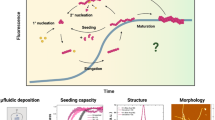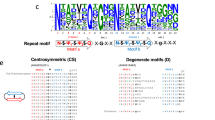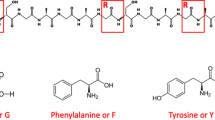Abstract
Amyloid or amyloid-like fibrils represent a general class of nanomaterials that can be formed from many different peptides and proteins. Although these structures have an important role in neurodegenerative disorders, amyloid materials have also been exploited for functional purposes by organisms ranging from bacteria to mammals. Here we review the functional and pathological roles of amyloid materials and discuss how they can be linked back to their nanoscale origins in the structure and nanomechanics of these materials. We focus on insights both from experiments and simulations, and discuss how comparisons between functional protein filaments and structures that are assembled abnormally can shed light on the fundamental material selection criteria that lead to evolutionary bias in multiscale material design in nature.
This is a preview of subscription content, access via your institution
Access options
Subscribe to this journal
Receive 12 print issues and online access
$259.00 per year
only $21.58 per issue
Buy this article
- Purchase on Springer Link
- Instant access to full article PDF
Prices may be subject to local taxes which are calculated during checkout





Similar content being viewed by others
References
Dobson, C. M. Protein misfolding, evolution and disease. Trends Biochem. Sci. 24, 329–32 (1999).
Jaroniec, C. P. et al. High-resolution molecular structure of a peptide in an amyloid fibril determined by magic angle spinning NMR spectroscopy. Proc. Natl Acad. Sci.USA 101, 711–716 (2004).
Luhrs, T. et al. 3D structure of Alzheimer's amyloid-beta(1–42) fibrils. Proc. Natl Acad. Sci.USA 102, 17342–17347 (2005).
Sawaya, M. R. et al. Atomic structures of amyloid cross-beta spines reveal varied steric zippers. Nature 447, 453–457 (2007).
Wasmer, C. et al. Amyloid fibrils of the HET-s(218–289) prion form a beta solenoid with a triangular hydrophobic core. Science 319, 1523–1526 (2008). Refs 2–5: structures of the amyloid cross-beta motifs illustrate many of the key characteristics of amyloid materials in atomic detail.
Sipe, J. D. & Cohen, A. S. Review: History of the amyloid fibril. J. Struct. Biol. 130, 88–98 (2000).
Tan, S. Y. & Pepys, M. B. Amyloidosis. Histopathology 25, 403–414 (1994).
Selkoe, D. J. Alzheimer's disease: Genes, proteins, and therapy. Physiol. Rev. 81, 741–766 (2001).
Antzutkin, O. N. et al. Multiple quantum solid-state NMR indicates a parallel, not antiparallel, organization of beta-sheets in Alzheimer's beta-amyloid fibrils. Proc. Natl Acad. Sci.USA 97, 13045–13050 (2000).
Bucciantini, M. et al. Inherent toxicity of aggregates implies a common mechanism for protein misfolding diseases. Nature 416, 507–511 (2002).
Tsai, H. H. et al. Energy landscape of amyloidogenic peptide oligomerization by parallel-tempering molecular dynamics simulation: significant role of Asn ladder. Proc. Natl Acad. Sci. USA 102, 8174–8179 (2005).
Pepys, M. B. Amyloidosis. Ann. Rev. Med. 57, 223–241 (2006).
Zanuy, D., Gunasekaran, K., Lesk, A. M. & Nussinov, R. Computational study of the fibril organization of polyglutamine repeats reveals a common motif identified in beta-helices. J. Mol. Biol. 358, 330–45 (2006).
Paravastu, A. K., Leapman, R. D., Yau, W. M. & Tycko, R. Molecular structural basis for polymorphism in Alzheimer's beta-amyloid fibrils. Proc. Natl Acad. Sci. USA 105, 18349–18354 (2008).
Chiti, F. & Dobson, C. M. Protein misfolding, functional amyloid, and human disease. Annu. Rev. Biochem. 75, 333–66 (2006). Overview of the principles of protein folding and misfolding.
Fowler, D. M. et al. Functional amyloid formation within mammalian tissue. PLoS Biol. 4, e6 (2006). Functional amyloid in the synthesis of melanin.
Fowler, D. M., Koulov, A. V., Balch, W. E. & Kelly, J. W. Functional amyloid-from bacteria to humans. Trends Biochem. Sci. 32, 217–24 (2007).
Kelly, J. W. & Balch, W. E. Amyloid as a natural product. J. Cell Biol. 161, 461–462 (2003).
Mostaert, A. S., Higgins, M. J., Fukuma, T., Rindi, F. & Jarvis, S. P. Nanoscale mechanical characterisation of amyloid fibrils discovered in a natural adhesive. J. Biol. Phys. 32, 393–401 (2006).
Watt, B. et al. N-terminal domains elicit formation of functional Pmel17 amyloid fibrils. J. Biol. Chem. 284, 35543–35555 (2009).
Spillantini, M. G. et al. α-Synuclein in Lewy bodies. Nature 388, 839–840 (1997).
Fandrich, M., Fletcher, M. A. & Dobson, C. M. Amyloid fibrils from muscle myoglobin. Nature 410, 165–166 (2001).
Dobson, C. M. Protein folding and misfolding. Nature 426, 884–90 (2003).
Keten, S., Xu, Z., Ihle, B. & Buehler, M. J. Nanoconfinement controls stiffness, strength and mechanical toughness of beta-sheet crystals in silk. Nature Mater. 9, 359–367 (2010).
Kol, N. et al. Self-assembled peptide nanotubes are uniquely rigid bioinspired supramolecular structures. Nano Lett. 5, 1343–1346 (2005).
Salvetat, J. P. et al. Elastic and shear moduli of single-walled carbon nanotube ropes. Phys. Rev. Lett. 82, 944–947 (1999).
Kis, A. et al. Nanomechanics of microtubules. Phys. Rev. Lett. 89, 248101 (2002).
Smith, J. F., Knowles, T. P. J., Dobson, C. M., MacPhee, C. E. & Welland, M. E. Characterization of the nanoscale properties of individual amyloid fibrils. Proc. Natl Acad. Sci.USA 103, 15806–15811 (2006).
Gittes, F., Mickey, B., Nettleton, J. & Howard, J. Flexural rigidity of microtubules and actin-filaments measured from thermal fluctuations in shape. J. Cell Biol. 120, 923–934 (1993).
Wang, J. C. et al. Micromechanics of isolated sickle cell hemoglobin fibers: Bending moduli and persistence lengths. J. Mol. Biol. 315, 601–612 (2002).
Adamcik, J. et al. Understanding amyloid aggregation by statistical analysis of atomic force microscopy images. Nature Nanotech. 5, 423–428 (2010).
Knowles, T. P. et al. An analytical solution to the kinetics of breakable filament assembly. Science 326, 1533–1537 (2009).
Meersman, F., Cabrera, R. Q., McMillan, P. F. & Dmitriev, V. Compressibility of insulin amyloid fibrils determined by X-ray diffraction in a diamond anvil cell. High Pressure Res. 29, 665–670 (2009).
Sachse, C., Grigorieff, N. & Fandrich, M. Nanoscale flexibility parameters of Alzheimer amyloid fibrils determined by electron cryo-microscopy. Angew. Chem. Int. Ed. 49, 1321–1323 (2010).
Knowles, T. P. et al. Role of intermolecular forces in defining material properties of protein nanofibrils. Science 318, 1900–1903 (2007). Determination of the rigidities of nanofibrils formed from a wide range of peptides and proteins.
Park, J., Kahng, B., Kamm, R. D. & Hwang, W. Atomistic simulation approach to a continuum description of self-assembled beta-sheet filaments. Biophys. J. 90, 2510–2524 (2006).
Paparcone, R., Keten, S. & Buehler, M. J. Atomistic simulation of nanomechanical properties of Alzheimer's A beta(1–40) amyloid fibrils under compressive and tensile loading. J. Biomechanics 43, 1196–1201 (2010).
Relini, A. et al. Detection of populations of amyloid-like protofibrils with different physical properties. Biophys. J. 98, 1277–1284 (2010).
Guo, S. & Akhremitchev, B. B. Packing density and structural heterogeneity of insulin amyloid fibrils measured by AFM nanoindentation. Biomacromolecules 7, 1630–1636 (2006).
Petkova, A. T. et al. Self-propagating, molecular-level polymorphism in Alzheimer's beta-amyloid fibrils. Science 307, 262–265 (2005).
Tanaka, M., Collins, S. R., Toyama, B. H. & Weissman, J. S. The physical basis of how prion conformations determine strain phenotypes. Nature 442, 585–589 (2006). Role of fibril fragmentation and nanomechanics in the propagation of yeast prion fibrils.
Dzwolak, W., Smirnovas, V., Jansen, R. & Winter, R. Insulin forms amyloid in a strain-dependent manner: An FT-IR spectroscopic study. Protein Sci. 13, 1927–1932 (2004).
Sigurdson, C. J. et al. Prion strain discrimination using luminescent conjugated polymers. Nature Meth. 4, 1023–1030 (2007). Luminescent conjugated polymers as powerful probes of polymorphism in protein aggregates.
Paparcone, R., Cranford, S. W. & Buehler, M. J. Self-folding and aggregation of amyloid fibrils Nanoscale 3, 1748–1755 (2011).
Huang, Y. Y., Knowles, T. P. J. & Terentjev, E. M. Strength of nanotubes, filaments, and nanowires from sonication-induced scission. Adv. Mater. 21, 3945–3948 (2009).
Streltsov, V. X-ray absorption and diffraction studies of the metal binding sites in amyloid beta-peptide. Eur. Biophys. J. 37, 257–263 (2008).
Ackbarow, T., Chen, X., Keten, S. & Buehler, M. J. Hierarchies, multiple energy barriers and robustness govern the fracture mechanics of alpha-helical and beta-sheet protein domains. Proc. Natl Acad. Sci. USA 104, 16410–16415 (2007).
Ma, B. & Nussinov, R. Stabilities and conformations of Alzheimer's beta-amyloid peptide oligomers (Abeta 16–22, Abeta 16–35, and Abeta 10–35): Sequence effects. Proc. Natl Acad. Sci. USA 99, 14126–14131 (2002).
Periole, X., Rampioni, A., Vendruscolo, M. & Mark, A. E. Factors that affect the degree of twist in beta-sheet structures: a molecular dynamics simulation study of a cross-beta filament of the GNNQQNY peptide. J. Phys. Chem. B 113, 1728–1737 (2009).
Lee, C. F., Loken, J., Jean, L. & Vaux, D. J. Elongation dynamics of amyloid fibrils: A rugged energy landscape picture. Phys. Rev. E 80, 041906 (2009).
Wei, G. H., Mousseau, N. & Derreumaux, P. Computational simulations of the early steps of protein aggregation. Prion 1, 3–8 (2007).
Xu, Z., Paparcone, R. & Buehler, M. J. Alzheimer's abeta(1–40) amyloid fibrils feature size-dependent mechanical properties. Biophys. J. 98, 2053–2062 (2010).
Auer, S. et al. Importance of metastable states in the free energy landscapes of polypeptide chains. Phys. Rev. Lett. 99, 178104 (2007).
Xu, Z. & Buehler, M. J. Mechanical energy transfer and dissipation in fibrous beta-sheet-rich proteins. Phys. Rev. E 81, 061910 (2010).
Fratzl, P. & Weinkamer, R. Nature's hierarchical materials. Prog. Mater. Sci. 52, 1263–1334 (2007).
Ashby, M. F., Gibson, L. J., Wegst, U. & Olive, R. The mechanical properties of natural materials. I. Material property charts. Proc. R. Soc. Lond. A 450, 123–140 (1995).
Wegst, U. G. K. & Ashby, M. F. The mechanical efficiency of natural materials. Phil. Mag. 84, 2167–2181 (2004).
Kreplak, L., Bar, H., Leterrier, J. F., Herrmann, H. & Aebi, U. Exploring the mechanical behavior of single intermediate filaments. J. Mol. Biol. 354, 569–577 (2005).
Yang, L. et al. Micromechanical bending of single collagen fibrils using atomic force microscopy. J. Biomed. Mater. Res. A 82, 160–168 (2007).
Shen, Z. L., Dodge, M. R., Kahn, H., Ballarini, R. & Eppell, S. J. Stress-strain experiments on individual collagen fibrils. Biophys. J. 95, 3956–3963 (2008).
Slotta, U. et al. Spider silk and amyloid fibrils: A structural comparison. Macromol. Biosci. 7, 183–188 (2007).
Vollrath, F. & Knight, D. P. Liquid crystalline spinning of spider silk. Nature 410, 541–548 (2001).
Collins, S. R., Douglass, A., Vale, R. D. & Weissman, J. S. Mechanism of prion propagation: amyloid growth occurs by monomer addition. PLoS Biol. 2, e321 (2004).
Shorter, J. & Lindquist, S. Destruction or potentiation of different prions catalyzed by similar Hsp104 remodeling activities. Mol. Cell 23, 425–438 (2006).
Paparcone, R. & Buehler, M. J. Failure of A-beta-(1–40) amyloid fibrils under tensile loading. Biomaterials 32, 3367–3374 (2011). Molecular mechanisms of failure of amyloid fibrils and influence of fibril length on mechanical properties.
Aguzzi, A. Cell biology: Beyond the prion principle. Nature 459, 924–925 (2009).
Prusiner, S. B. Molecular biology of prion diseases. Science 252, 1515–1522 (1991).
Riek, R. Cell biology: infectious Alzheimer's disease? Nature 444, 429–431 (2006).
Eisele, Y. S. et al. Peripherally applied A beta-containing inoculates induce cerebral beta-amyloidosis. Science 330, 980–982 (2010).
Aguzzi, A. & Rajendran, L. The transcellular spread of cytosolic amyloids, prions, and prionoids. Neuron 64, 783–790 (2009).
Koffie, R. M. et al. Oligomeric amyloid beta associates with postsynaptic densities and correlates with excitatory synapse loss near senile plaques. Proc. Natl Acad. Sci. USA 106, 4012–4017 (2009).
Haass, C. & Selkoe, D. J. Soluble protein oligomers in neurodegeneration: lessons from the Alzheimer's amyloid beta-peptide. Nature Rev. Mol. Cell Biol. 8, 101–112 (2007).
Gebbink, M. F. B. G., Claessen, D., Bouma, B., Dijkhuizen, L. & Wosten, H. A. B. Amyloids - A functional coat for microorganisms. Nature Rev. Microbiol. 3, 333–341 (2005).
Maji, S. K. et al. Functional amyloids as natural storage of peptide hormones in pituitary secretory granules. Science 325, 328–332 (2009). Discovery of functional amyloid in the endocrine system.
Chapman, M. R. et al. Role of Escherichia coli curli operons in directing amyloid fiber formation. Science 295, 851–855 (2002). Involvement of functional amyloid in bacterial biofilm production.
Shorter, J. & Lindquist, S. Prions as adaptive conduits of memory and inheritance. Nature Rev. Genet. 6, 435–450 (2005).
Meyer-Luehmann, M. et al. Rapid appearance and local toxicity of amyloid-beta plaques in a mouse model of Alzheimer's disease. Nature 451, 720–724 (2008).
Barnhart, M. M. & Chapman, M. R. Curli biogenesis and function. Annu. Rev. Microbiol. 60, 131–147 (2006).
Hammer, N. D., Schmidt, J. C. & Chapman, M. R. The curli nucleator protein, CsgB, contains an amyloidogenic domain that directs CsgA polymerization. Proc. Natl Acad. Sci. USA 104, 12494–12499 (2007).
Zhang, S. G., Holmes, T., Lockshin, C. & Rich, A. Spontaneous assembly of a self-complementary oligopeptide to form a stable macroscopic membrane. Proc. Natl Acad. Sci. USA 90, 3334–3338 (1993).
Zhang, S. G. Fabrication of novel biomaterials through molecular self-assembly. Nature Biotechnol. 21, 1171–1178 (2003).
Lovett, M. et al. Silk fibroin microtubes for blood vessel engineering. Biomaterials 28, 5271–5279 (2007).
Keten, S. & Buehler, M. J. Geometric confinement governs the rupture strength of H-bond assemblies at a critical length scale. Nano Lett. 8, 743–748 (2008).
MacPhee, C. E. & Dobson, C. M. Formation of mixed fibrils demonstrates the generic nature and potential utility of amyloid nanostructures. J. Am. Chem. Soc. 122, 12707–12713 (2000).
Reches, M. & Gazit, E. Casting metal nanowires within discrete self-assembled peptide nanotubes. Science 300, 625–627 (2003). Directing metal deposition through self-assembling peptide scaffolds.
Carny, O., Shalev, D. E. & Gazit, E. Fabrication of coaxial metal nanocables using a self-assembled peptide nanotube scaffold. Nano Lett. 6, 1594–1597 (2006).
Lu, W. & Lieber, C. M. Nanoelectronics from the bottom up. Nature Mater. 6, 841–850 (2007).
Scheibel, T. et al. Conducting nanowires built by controlled self-assembly of amyloid fibers and selective metal deposition. Proc. Natl Acad. Sci. USA 100, 4527–4532 (2003). Synthesis of metallic nanowires through self-assembling peptide scaffolds.
Niu, L. J., Chen, X. Y., Allen, S. & Tendler, S. J. B. Using the bending beam model to estimate the elasticity of diphenylalanine nanotubes. Langmuir 23, 7443–7446 (2007).
Reches, M. & Gazit, E. Controlled patterning of aligned self-assembled peptide nanotubes. Nature Nanotech. 1, 195–200 (2006).
Adler-Abramovich, L. et al. Self-assembled arrays of peptide nanotubes by vapour deposition. Nature Nanotech. 4, 849–854 (2009).
Hamley, I. W. et al. Alignment of a model amyloid peptide fragment in bulk and at a solid surface. J. Phys. Chem. B 114, 8244–8254 (2010).
Knowles, T. P. J., Oppenheim, T., Buell, A. K., Chirgadze, D. Y. & Welland, M. E. Nanostructured biofilms from hierarchical self-assembly of amyloidogenic proteins. Nature Nanotech. 5, 204–207 (2010).
Barrau, S. et al. Integration of amyloid nanowires in organic solar cells. Appl. Phys. Lett. 93, 023307 (2008).
Channon, K. J., Devlin, G. L. & MacPhee, C. E. Efficient energy transfer within self-assembling peptide fibers: A route to light-harvesting nanomaterials. J. Am. Chem. Soc. 131, 12520–12521 (2009).
Liang, Y. et al. Light harvesting antenna on an amyloid scaffold. Chem. Commun. 6522–6524 (2008).
Maji, S. K. et al. Amyloid as a depot for the formulation of long-acting drugs. PLoS Biol. 6, e17 (2008).
Holmes, T. C. et al. Extensive neurite outgrowth and active synapse formation on self-assembling peptide scaffolds. Proc. Natl Acad. Sci. USA 97, 6728–6733 (2000).
Ellis-Behnke, R. G. et al. Nano neuro knitting: Peptide nanofiber scaffold for brain repair and axon regeneration with functional return of vision. Proc. Natl Acad. Sci. USA 103, 5054–5059 (2006). Refs 98 and 99: tissue engineering using amyloid scaffolds.
Gras, S. L. et al. Functionalised amyloid fibrils for roles in cell adhesion. Biomaterials 29, 1553–1562 (2008).
Gimona, M. Protein linguistics - a grammar for modular protein assembly? Nature Rev. Mol. Cell Biol. 7, 68–73 (2006).
Diaz-Avalos, R. et al. Cross-beta order and diversity in nanocrystals of an amyloid-forming peptide. J. Mol. Biol. 330, 1165–1175 (2003).
Hemingway, E. The Old Man and the Sea (Vintage Books, 2007).
Nelson, R. et al. Structure of the cross-β spine of amyloid-like fibrils. Nature 435, 773–778 (2005).
Galkin, V. E., Orlova, A., Cherepanova, O., Lebart, M-C. & Ebelman, E. H. High-resolution cryo-EM structure of the F-actin-fimbrin/plastin ABD2 complex. Proc. Natl Acad. Sci. USA 105, 1494–1498 (2008).
Li, H., DeRosier, D. J., Nicholson, W. V., Nogales, E. & Downing, K. H. Microtubule structure at 8 A resolution. Structure 10, 1317–1328 (2002).
Acknowledgements
T.P.J.K. acknowledges support from St John's College, Cambridge. M.J.B. acknowledges support from the Office of Naval Research (YIP and PECASE Awards), National Science Foundation (CAREER), Army Research Office and the Air Force Office of Scientific Research. We also acknowledge helpful discussions with D. Kaplan, A. Aguzzi, L. Luheshi, D. White and C. Dobson.
Author information
Authors and Affiliations
Corresponding authors
Ethics declarations
Competing interests
The authors declare no competing financial interests.
Rights and permissions
About this article
Cite this article
Knowles, T., Buehler, M. Nanomechanics of functional and pathological amyloid materials. Nature Nanotech 6, 469–479 (2011). https://doi.org/10.1038/nnano.2011.102
Published:
Issue Date:
DOI: https://doi.org/10.1038/nnano.2011.102
This article is cited by
-
gp120-derived amyloidogenic peptides form amyloid fibrils that increase HIV-1 infectivity
Cellular & Molecular Immunology (2024)
-
Cryo-EM structure and polymorphic maturation of a viral transduction enhancing amyloid fibril
Nature Communications (2023)
-
Histidine modulates amyloid-like assembly of peptide nanomaterials and confers enzyme-like activity
Nature Communications (2023)
-
Data-mining unveils structure–property–activity correlation of viral infectivity enhancing self-assembling peptides
Nature Communications (2023)
-
Amyloid formation as a protein phase transition
Nature Reviews Physics (2023)



